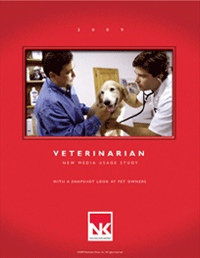 Nicholson Kovac has once again documented what agrimarketers know intuitively. This time it’s about veterinarians. The agency just released its Veterinarian New Media Usage Study. It has some interesting findings that should help make marketing decisions using new media easier to justify.
Nicholson Kovac has once again documented what agrimarketers know intuitively. This time it’s about veterinarians. The agency just released its Veterinarian New Media Usage Study. It has some interesting findings that should help make marketing decisions using new media easier to justify.
The Veterinarian New Media Usage Study provides comprehensive insight on the use of new and social media among veterinarians – including Internet usage, social networking and mobile phone activities − for business and social purposes.
“This eye-opening research shows that veterinarians are using a number of new tools to communicate with their customers and staff. Many of them send text messages to practice or clinic staff and other veterinarians,” said Sheree Johnson, Nicholson Kovac’s senior vice president, director of media services. “We also found it interesting that text messaging may serve as a customer service tool – a growing number of veterinarians, especially those who work with large animals, are also sending texts to their customers, possibly about the status of their animals.”
For more details read:
The 83-page study also explores in detail the Internet usage of both groups of veterinarians as well as their activity level in social networking sites:
· 91 percent of small animal veterinarians check Web sites related to animal health, while 92 percent of large animal veterinarians check animal health-related Web sites.
· Both groups also have Web sites established related to their practices (70 percent of small animal veterinarians versus 43 percent of large animal veterinarians).
· 20 percent of both groups have accounts on Twitter™.
· Veterinarians are social media savvy – 85 percent have visited Facebook™, 33 percent have visited MySpaceTM.
To put context to this custom research, the Veterinarian New Media Usage Study includes insights about the new media activities of dog and cat owners compared to U.S. adults. This existing data sheds light on how dog and cat owners are utilizing the Internet, text messaging and social networking sites compared to the average U.S. population. For example, cat owners are 31 percent more likely to use social networking sites every day versus the average adult; dog owners are 15 percent more likely to use social media sites.
“Pet owners really seem to be online more often than the average U.S. adult,” said Johnson. “In an age where more and more people are developing their pets ‘personalities’ online, we felt this data sheds light on some key online behaviors within this population. It certainly shows a difference in the way dog owners versus cat owners operate.”
Findings were based on the insights of 425 small and large animal veterinarians who completed a proprietary online survey in September and October 2009. The bonus Pet Owner report, which follows the proprietary veterinarian report, reflects highlights from Nicholson Kovac resources* profiling dog and cat owners. Detailed study findings, including demographics of participants and other highlights, are now available and can be purchased for $850 by visiting Nicholson Kovac’s Web site (www.nicholsonkovac.com) or at www.vetnewmediastudy.com.
